Charger SysMax/NiteCore Intellicharger i4 V2
This review is about the V2 version of the Sysmax/NiteCore/JetBeam i4 charger. To see the difference between V1 and V2 follow this link
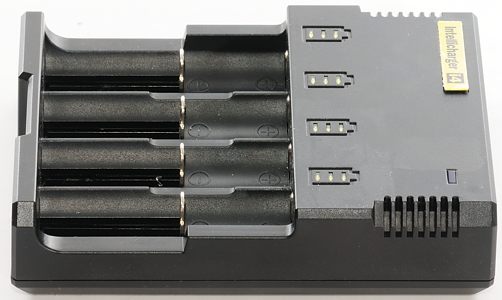

SysMax is the parent company of NiteCore and JetBeam, i.e. they are behind some good products. This charger looks impressive when reading the specifications, it can charge nearly all types of round cells and do up to four cells at a time. The current version is an updated version of the i4 charger I first reviewed, where most of my issues is supposed to be fixed.
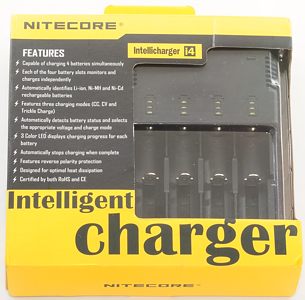
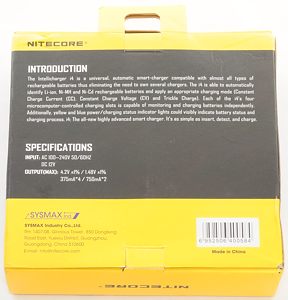

The charger comes in a cardboard box with a view to the charger and a feature list on the front. On the side is printed a list of supported batteries.

The charger is powered from either 110/220 VAC 50/60Hz or 12 VDC. Only a mains cable is included on the version I got.
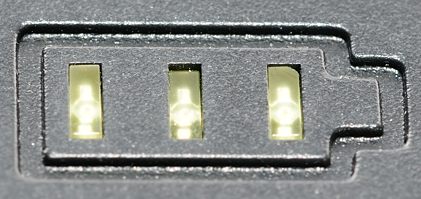
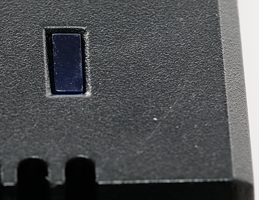
The charger has 3 yellow leds for each battery, they will show the actual charge state when charging:
None: no battery detected
1 flashing, 1 steady + 1 flashing, 2 steady + 1 flashing: Charging, number of leds is a rough guide to actual charge level.
3 steady: Battery is full.
3 flashing: Fail.
The charger also has a blue led to show "power connected".
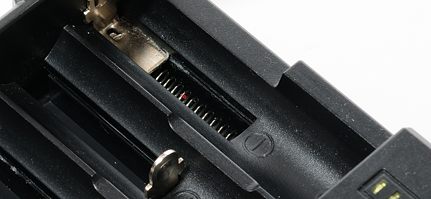
The cradles in the charger can handle from 16340 to 18700 size, but they do not slide completely smooth. When pressing at the top of the slider it may lock.
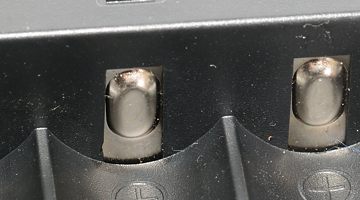
On the V2 charger the connection to the plus pole on the battery is longer, this makes the charger better for use with 26xx0 and C batteries, but not perfect (I have some C batteries with a small button top, they need a coin in front of them to connect).
Remember that with 26xx0 and C batteries, the charger has only space for max two at a time.


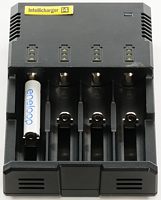
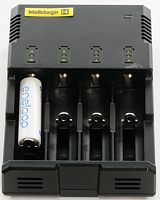
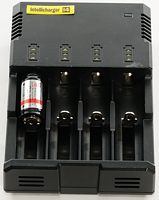
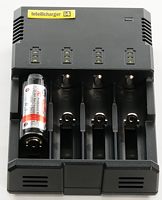
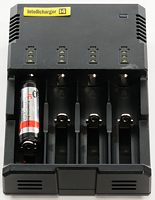
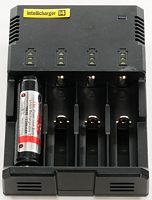

The charger can handle 70 mm long batteries, including flat top cells. (See my 18650 LiIon comparison for length of different brands).
With 26650/26500/C cells there can be a problem, if they have a small button top, but the problem is much less than the V1 charger.
With 10440 LiIon cells the charge current is too high and Sysmax/NiteCore recommend always to charge two batteries together, to reduce the current.
Measurements
The charger has two charger channels, one channel is handling slot #1 and #3, the other channel is handling slot #2 and #4. When charging cells in both slots for a channel, time division is used to distribute the charge (See scope traces).
Below 0.74 volt the charger will report error (all 3 yellow leds are flashing), but a small current will flow (about 500uA), this is enough to reset a LiIon protection circuit.
Between 0.74 volt and 2.2 volt charger will use the NiMH charge algorithm (See curve below).
Between 2.2 volt and 4.2 volt the charger will use the LiIon charge algorithm (See curve below).
There is no trickle charging on either NiMH or LiIon.
The charge stops LiIon charging when the current is below 44 mA, when the charger is finishes the current goes below 120uA (This is a nearly insignificant current).
The charger will not restart charging when the cell voltage drops.
When a battery is put into the charger, it will start charging and first stop when final charge condition is reached.
When power is connected the charger will start charging and first stop when final charge condition is reached.
When charger is disconnected from power, but with a battery in, it will draw less than 220 uA from a LiIon battery and less than 50uA with NiMH, current draw from each battery will be reduced when there are more batteries in the charger.
Test with LiIon cells
.png)
The charge curve shows a very good CC/CV charge curve, the termination current is perfect for many 18650 at 44 mA and very useable for smaller batteries. The charge time is 6 hours.
.png)
My old 16340 IMR cell. Due to the high impedance of the old cell, the charger goes into CV phase nearly immediately.
This curve starts the CV phase at a lower voltage than above, this is strange and probably means that the CC/CV curve is computer controlled and not implemented as a current limited constant voltage generator.
.png)
Channel #2
.png)
Channel #3
Note: The oscillations in the average current is probably due to my measuring setup and not present on the charger.
.png)
Channel #4
.png)
All four slots at the same time. The charge time is longer because the two charge channels need to share current between the four slots. The charge time is 11 hours.
Notice the bump in charge current just before the charger stops. This is because the second slot for that charge channel finished first and the full current is directed to the first slot where the measuring equipment is connected.
%20115VAC.png)
Doing the same with a 115 VAC 50Hz supply does also work perfect.
%20105VAC.png)
I also tested with 105 VAC 50Hz and there the charger did reset a couple of times during the charge (The "average current" jumps up and down), but the end result was the same, i.e. a good CC/CV charge curve.
Note: 50Hz will provoke problems at higher voltage than 60Hz, i.e. at 60Hz it might have worked fine at 105 VAC.
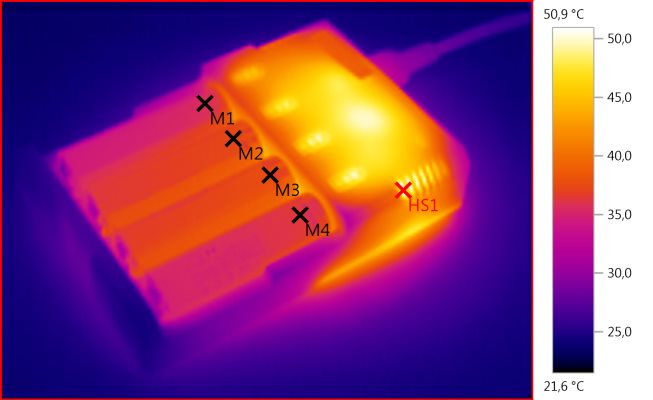
M1: 35,7°C, M2: 37,3°C, M3: 37,6°C, M4: 36,5°C, HS1: 50,9°C
The batteries are heated by the charger, but not above the maximum allowable temperature.
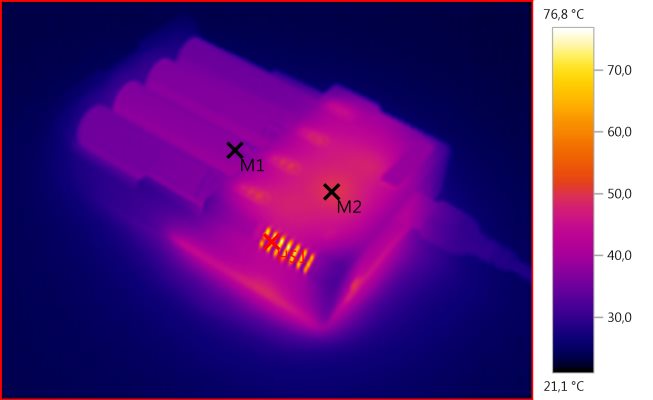
M1:37,1°C, M2: 49,9°C, HS1: 76,8°C
Inside the charger there is some warm electronic, as long as the electronic and box is designed for this temperature, it is not a problem.
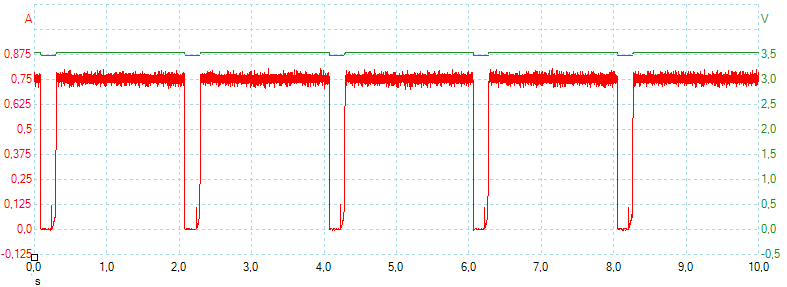
The full charge curve does not show how the charge current looks. For this a oscilloscope trace is needed, it shows a pulsing current. The charging circuits stops every two second to check the other slot.
The charging current is off 10% of the time.

With a LiIon in two slots, shared by the same charging channel, the charging is two seconds for each slot.
Test with NiMH
For testing I uses eneloop AA cells, these are a very good quality NiMH batteries with about 1950 mAh in capacity from new, mine is probably lower because they are more than a year old.
.png)
The NiMH AA cell does charge with a constant current until the charger terminates. But the termination is not a -dv/dt terminations. The charge time is 2.8 hours.
%20-%20tail.png)
Here is a close look at the last few minutes of the above trace. With a -dv/dt the voltage is supposed to stay constant or drop slightly, before the charger terminates.
.png)
A new Eneloop XX cell.
.png)
This test was with a old non LSD NiMH battery.
.png)
Slot #2
.png)
With 4 eneloop the charge current goes down, but everything else works as before. The charge time is 5.4 hours.
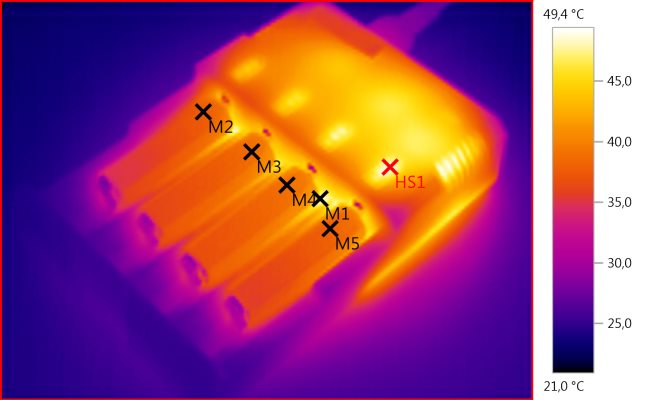
M1: 48,4°C, M2: 37,7°C, M3: 38,9°C, M4: 39,0°C, M5: 38,1°C, HS1: 49,4°C
NiMH batteries gets warmer than LiIon.
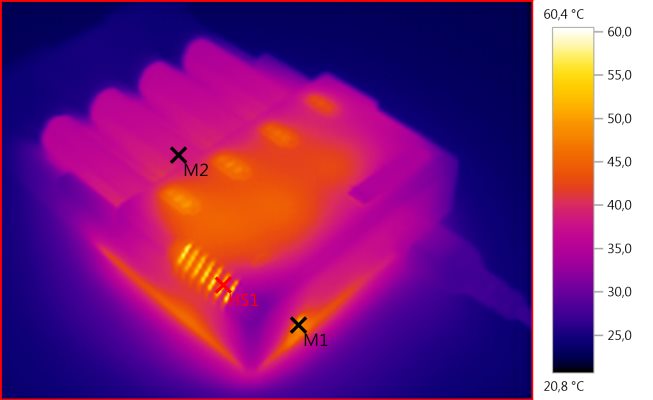
M1: 50,8°C, M2: 38,4°C, HS1: 60,4°C
I did probably not hit the right angle to get the hottest part (See LiIon images), but it is still fairly warm.
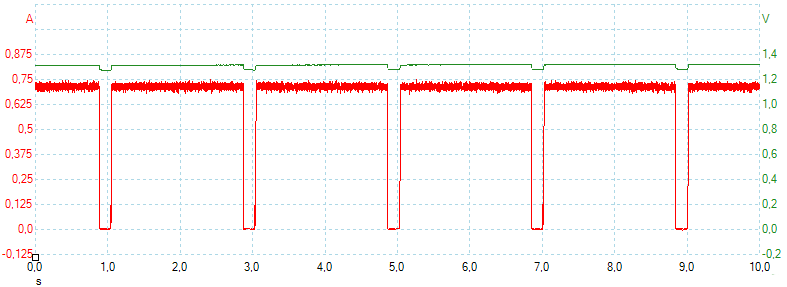
Charging is with pulsing current (Exactly like LiIon).
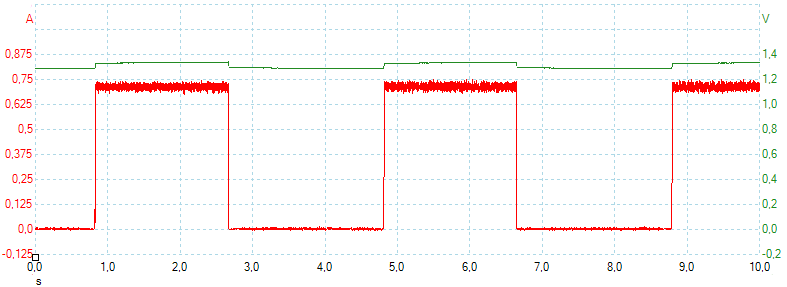
With a eneloop in all slots, the charging is two seconds for each slot.
Test with NiMH and LiIon and the same time
The specification says it can handle both types of batteries and does not include any limits on this.
.png)
First charge curve is measured on a LiIon with a NiMH in the other slot. This works perfectly, after 5½ hours the eneloop is finished and the LiIon battery gets the full charge current, until it is full after 8 hours.
.png)
This curve is measured on a eneloop with a LiIon in the other slot. This looks exactly like the 4xeneloop chart.
The problem in the V1 with charging different chemistries at the same time is completely solved.
Summary
A short list of the good and the bad things with the charger. I uses ++ for the really good things. things.
++ The charger uses a CC/CV algorithm.
++ The slots are long enough, all protected 18650 will fit.
+ The charger can be used on 12 volt.
+ Good indicator lights with estimation of charge in cells.
+ Can reset a LiIon protection circuit.
+ The slider has good connection with anything from 16340 to 18650 cells.
+ The charger is universal voltage, i.e. it can work on both 110/115/220/230 VAC.
- The charge current is too high for 10440 cells.
- The NiMH charge mode prevents correct handling of over discharged LiIon (This is unavoidable in a multi chemistry charger with automatic selection).
- The slider does not always move easily, when putting long cells in the charger.
- The NiMH charging algorithm does not use -dv/dt termination.
Conclusion
This charger uses a CC/CV charging profile, this is the recommended way to charge LiIon batteries. The charge current is a good compromise for handling many battery sizes with only one current setting.
The charger also does a good job on NiMH batteries, but I wonder about the termination.
I will call it a good universal charger.
Notes
Thermo images has been added later and is not including in the general evaluation of the charger.
The charger was supplied by SysMax for a review.
All tests are done at 230 VAC mains supply, except when otherwise specified.
In the V1 review there was a pattern in the current, this was because my sample rate was exactly 1 second and made interference with the 2 second pulsing. In this test I have changed the sample rate to 0.9 second and mostly avoided the interference (It does show up in the "average current" as oscillations).
Here is an explanation on how I did the above charge curves: How do I test a charger



















.png)
.png)
.png)
.png)
.png)
.png)
%20115VAC.png)
%20105VAC.png)




.png)
%20-%20tail.png)
.png)
.png)
.png)
.png)




.png)
.png)